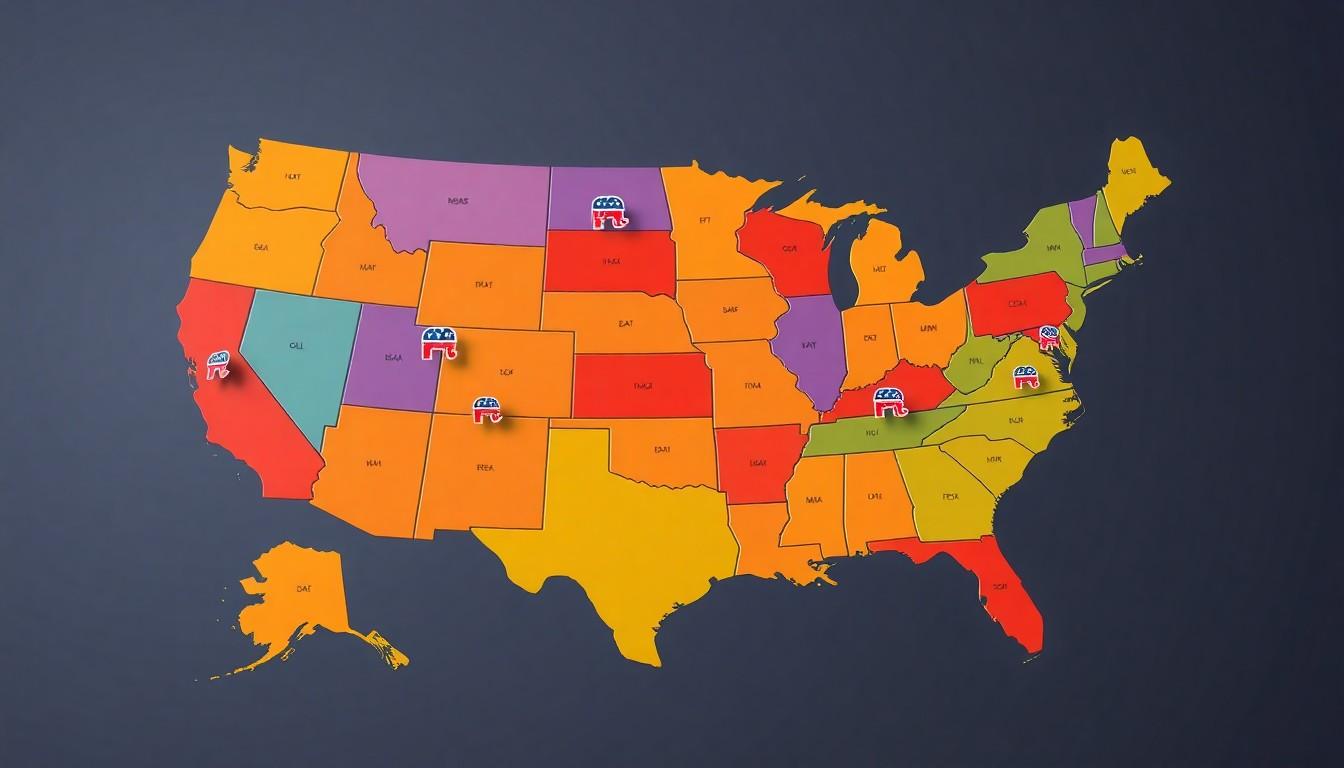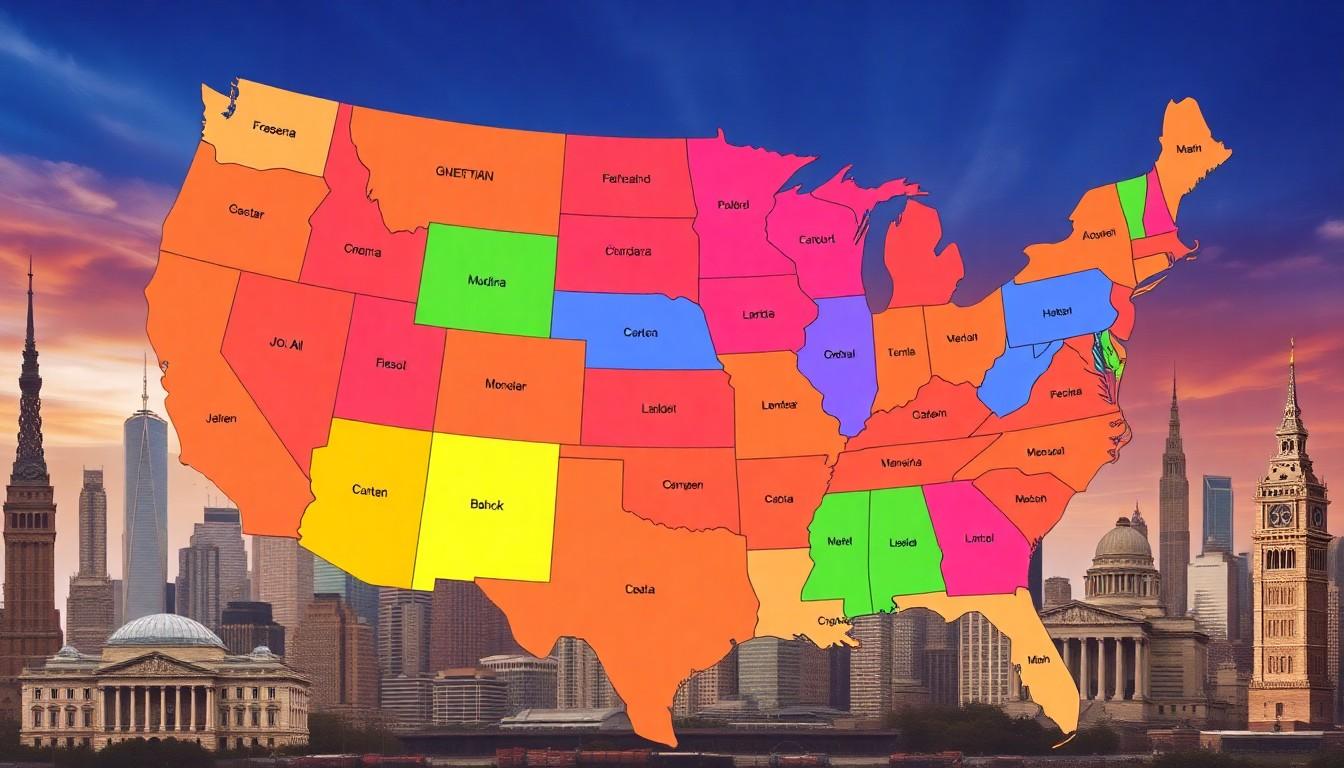Phone:
(701)814-6992
Physical address:
6296 Donnelly Plaza
Ratkeville, Bahamas.

Navigating the political landscape of the United States can feel like trying to find your way through a maze designed by a particularly mischievous raccoon. With states that seem to change colors more often than a chameleon at a disco, understanding the political map is crucial for anyone wanting to stay informed.
From the fiery debates in the heart of Congress to the quiet whispers of local elections, each state tells a unique story. Whether you’re a political junkie or just someone trying to avoid awkward conversations at family gatherings, grasping the nuances of the political map can give you the edge. So buckle up and get ready to explore the vibrant and ever-changing tapestry of American politics—because in this game, knowledge isn’t just power; it’s the ultimate cheat code.
The political map of the United States serves as a crucial tool for understanding the country’s governance structure. Each state displays its unique political landscape, which reflects diverse voting patterns and party affiliations. By examining recent election results, one can observe how various regions lean toward specific political parties.
States like California typically align with the Democratic Party, while Texas predominantly supports the Republican Party. This division in political loyalty is evident in the distribution of electoral votes during presidential elections. The map also highlights congressional districts, which impact legislative representation at both state and federal levels.
Additionally, state boundaries often encompass distinct cultural and economic influences. Observing these connections reveals significant variations in policy priorities and governance approaches across the nation. For instance, southern states may prioritize issues such as agriculture, while northeastern states often focus on urban concerns.
In recent years, redistricting has affected many states, altering the political landscape and potentially shifting power dynamics. Changes in population demographics also play a critical role, as migration patterns can influence political leanings and voting behaviors.
Voter turnout is another key element showcased on these maps. Higher turnout rates often correlate with increased engagement in local and national issues, shaping political outcomes. Understanding these complexities provides a clearer picture of the dynamic nature of American politics, emphasizing the importance of staying informed about changes and trends.

Political maps hold substantial value in understanding the intricate landscape of the United States. They serve as critical tools for analyzing voter behavior and party dynamics across different regions.
Political maps illustrate the division of states and regions, showcasing the geographical implications of power dynamics. Each area reflects unique political affiliations impacting national policies. This representation clarifies the influence of specific states during elections, where swing states often hold pivotal roles. Understanding geographical trends aids in grasping how local issues interact with national politics. For instance, states with high electoral votes, such as California and Texas, significantly sway federal elections. Recognizing these patterns provides insights into national governance and the effectiveness of political strategies.
Political maps function as educational resources for students and citizens alike. These maps foster a deeper comprehension of political systems and electoral processes. In classrooms, educators utilize maps to engage students in discussions about democracy and civic responsibilities. For example, students analyze various voting trends, exploring how demographics influence election outcomes. Interactive maps further enhance learning by illustrating historical changes over time. Knowledge gained through these resources empowers individuals to participate more actively in their communities and advocacy efforts. Understanding political boundaries contributes directly to informed voting decisions and political discourse.
Political maps of the United States feature essential elements that define its structure and function in governance. Understanding these features ensures insights into the country’s political dynamics.
State boundaries are clearly marked on political maps, indicating the limits of each state’s jurisdiction. These lines reflect historical treaties, geographical landmarks, and legislative decisions. Variations in boundaries can directly affect representation in congressional districts and influence electoral outcomes. Redistricting practices further complicate the political landscape, as states occasionally redraw borders to reflect population shifts. Thus, the impact of state boundaries extends beyond geographical delineation, shaping the political identities and policies of each region.
Major cities and capitals stand out on political maps, representing centers of political power and influence. Capitals serve as hubs for state government activity, while major cities often drive economic and cultural development. Each state’s capital, such as Sacramento in California or Austin in Texas, plays a pivotal role in local governance and policy-making. Urban areas bring diverse populations and ideologies, creating a rich tapestry of voter behavior. Recognizing the significance of these cities contributes to a deeper understanding of regional political dynamics and electoral strategies.
Political maps in the United States have undergone significant changes over time, reflecting the nation’s evolving governance and demographics. Understanding this evolution helps appreciate the complexities involved in the current political landscape.
Early political maps emerged during critical moments in U.S. history, such as the American Revolution and westward expansion. These maps depicted colonial territories and facilitated discussions about boundaries, governance, and representation. They established a foundation that influenced early legislative decisions, including the creation of states. Maps at this time often illustrated regions according to population density and resources. These early representations shaped political thought and initiated debates on federalism, statehood, and local governance.
Over the years, political maps have transformed in response to significant historical events and societal shifts. The Civil War prompted major changes, including the redrawing of borders and the introduction of new states. The post-war era saw a focus on demographic shifts, reflecting migration patterns and urbanization. Changes in technology, such as satellite imagery, allow for more precise mapping. Redistricting has emerged as a crucial factor determining congressional representation following census data. Political maps now also highlight swing states, shaping presidential election strategies and outcomes. Understanding these changes provides insights into the ongoing evolution of the political landscape in the U.S.
Technological advancements significantly shape the political landscape in the United States. These innovations provide new ways to visualize and understand complex data.
Digital mapping tools enable analysts to create precise political maps easily. Geographic Information Systems (GIS) play a crucial role in gathering and analyzing data. Users can overlay various data points, such as demographic information and voting patterns. This capability allows for more accurate representation of shifts in political dynamics. As a result, political strategists benefit from real-time data analysis, enhancing their ability to make informed decisions during campaigns.
Interactive political maps engage users by allowing them to explore data personally. Features such as zooming in on specific states or districts offer detailed views of electoral trends. Users can manipulate variables, such as party affiliations and voting history, to see how they impact overall results. These tools foster a better understanding of the complexities involved in voter behavior. By engaging citizens with interactive elements, these maps promote informed discussions about electoral processes and encourage civic participation.
Understanding the political map of the United States is essential for anyone looking to engage with the nation’s complex political landscape. Each state tells a unique story influenced by its history culture and demographics. This knowledge not only enhances discussions but also empowers individuals to participate actively in their communities.
As political dynamics continue to evolve the importance of staying informed cannot be overstated. Utilizing modern tools like GIS and interactive maps can provide deeper insights into voter behavior and party affiliations. By embracing these resources individuals can navigate the intricacies of American politics with confidence and clarity.